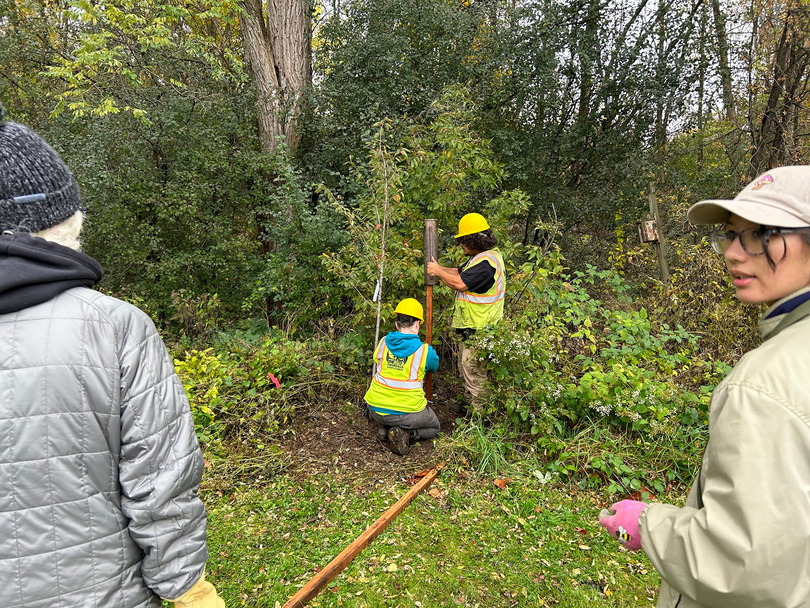Syracuse Urban Food Forest Project plants 180 trees to expand edible urban landscapes

Olivia Moody | Staff Photographer
SUFFP’s project with the grant, entitled Green Infrastructure: Infiltrating Water and Invigorating Neighborhoods, is expected to span multiple years and include various species of edible plants as part of the goal to protect the watershed.
Get the latest Syracuse news delivered right to your inbox.
Subscribe to our newsletter here.
Around 50 people from the Syracuse area gathered Saturday for a community tree planting event hosted by the Syracuse Urban Food Forest Project, a collaboration between Syracuse University and SUNY ESF that works to promote edible urban landscapes in the city.
The tree planting event, which began at Corcoran High School, promoted foraging and sustainable urban ecology in the Elmwood and South Side neighborhoods of Syracuse. SUFFP worked with the Onondaga Earth Corps to organize the volunteer event.
Attendees were set to plant a total of 180 trees during the community event, according to SUFFP’s Facebook page. The event also provided an opportunity for community members to create a closer relationship with the food they consume, organizers from SUFFP said.
“The unique thing about our project is that it also is engaging communities, creating a connection and maybe stronger stewardship because the plantings are also edible plantings,” said Matthew Potteiger, a founding member of SUFFP and professor of landscape architecture at ESF. “People have a new level of connection with the ecosystem basically by eating it.”
Arcènia Notilija, a graduate student in SU’s nutrition and food studies program, said she’s been volunteering with the SUFFP for over a year. With her experience, Notilija said she’s seen the connections community members develop with the foods they consume through SUFFP’s planting events.
“When (we) think about where to get food, we think about supermarkets and supermarket shelves and there is more to that,” Notilija said. “Food is not only that, it’s being here with people in nature and understanding where our food is coming from.”

Cindy Zhang | Digital Design Director
SUFFP was founded in 2019 as a way to help the Syracuse community connect with local natural resources through ecology, landscape design and urban food policy with events like community tree planting, according to its website.
Through a grant from the U.S. Department of Agriculture called the Great Lakes Restoration Initiative, SUFFP was able to purchase tree saplings to plant, including hickories, pecans, sugar maple, serviceberries, redbuds, persimmons and pawpaws. These trees will help protect the Onondaga Lake watershed in Syracuse’s Elmwood and South Side neighborhoods, Potteiger said.
SUFFP’s project with the grant, entitled Green Infrastructure: Infiltrating Water and Invigorating Neighborhoods, is expected to span multiple years and include various species of edible plants as part of the goal to protect the watershed.
The project will extend between Onondaga Community College’s campus and Syracuse’s Inner Harbor, according to Katherine Korba, an urban forestry professor at ESF and member of SUFFP. While the SUFFP focuses on the watershed as a whole, Saturday’s event focused on Elmwood Park, located along the edge of Corcoran High School.
Ian Davis, a sophomore biochemistry major at ESF and member of SUFFP, said SUFFP’s tree-planting efforts allows people to gain independence in accessing food while navigating food deserts.
“In addition to just getting additional sources of food that don’t fluctuate with market costs, it’s also kind of rescuing that feeling of, ‘I can go out into the world and (get food) without having to spend an exorbitant sum of money,’” Davis said.
Maureen Curtin, a Syracuse resident and associate professor of English at SUNY Oswego, said she regularly forages mulberries in Elmwood and Onondaga Park with her daughter. Curtin said that while she believes foraging is a good way for people to spend more time outside, she understands that it does not solve Syracuse’s food desert problem entirely.
“(Foraging is) not a foolproof solution, you know, it’s not going to meet everyone’s needs,” she said. “But it puts people more in contact with the natural world around them.”
The Great Lakes Restorative Initiative funding for SUFFP will last for two more years, Potteiger said. He added that the organization will continue community planting events and also expand to promote animal ecology in the region.
“It’s part of a larger movement to look at edible ecologies and transforming urban infrastructure to create new ecological infrastructure that’s also edible and affordable,” Potteiger said.





